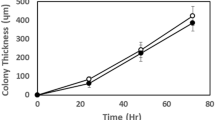Abstract
The effects of glucose and nitrogen depletion on the colonization of glass Petri plates byPseudomonas fluorescens were studied in batch culture. Colonization of the surfaces was initiated before colonization of the bulk phase, and biofilm formation was observed. This resulted in an apparent lag in the batch growth curve for the cell suspension. The lag phase was an artifact caused by the partitioning of cells between the bulk and solid phase of the culture and was not due to a reduction in the growth rate of unattached cells. The specific growth rate of the unattached cells (0.331 hour−1) was almost twice that determined for the total population (0.171 hour−1). Consequently the growth rate of biofilm-forming bacteria cannot be determined in batch culture unless the growth of both attached and unattached cells is monitored, and batch growth curves may contain artifacts due to the formation and dispersion of biofilms. The depletion of either glucose or nitrogen led to the active detachment of cells from the biofilm. An increase in the hydrophobicity of unattached cells was noted on depletion of carbon. This increase was the result of emigration of cells from the surface into the bulk phase.
Similar content being viewed by others
References
Belas RM, Colwell RR (1982) Scanning electron microscope observations of the swarming phenomenon ofVibrio parahaemolyticus. J Bacteriol 150:956–959
Brown CM, Ellwood DC, Hunter VR (1977) Growth of bacteria at surfaces: Influence of nutrient limitation. FEMS Microbiol Lett 1:163–166
Bradford M (1976) A rapid and sensitive method for the quantitation of microgram quantities of protein utilizing the principle of protein-dye binding. Anal Biochem 72:248–54
Caldwell DE, Lawrence JR (1986) Growth kinetics ofPseudomonas fluorescens microcolonies within the hydrodynamic boundary layers of surface microenvironments. Microb Ecol 12:299–312
Characklis WG, Cooksey KE (1983) Biofilms and microbial fouling. Adv Appl Microbiol 29:93–138
Corpe WA (1974) Detachment of marine periphytic bacteria from surfaces. Dev Ind Microbiol 15:281–287
Costerton JW (1985) In: Savage DC, Fletcher M (eds) Bacterial adhesion. Mechanisms and physiological significance. Plenum Press, New York
Costerton JW, Geesey GG, Cheng KJ (1978) How bacteria stick. Sci Am 238:86–95
Dawson MP, Humphrey BA, Marshall KC (1981) Adhesion: A tactic in the survival strategy of a marineVibrio during starvation. Current Microbiol 6:195–199
Ellwood DC, Keevil CW, Marsh PD, Brown CM, Wardell JN (1982) Surface associated growth. Philos Trans R Soc Lond 297:517–532
Fraser TW, Gilmour A (1986) Scanning electron microscopy preparation methods: Their influence on the morphology and fibril formation inPseudomonas fragi (ATCC 4973). J Appl Bacteriol 60:527–533
Hogg SD, Manning GE (1987) The hydrophobicity of ‘viridans’ streptococci isolated from the human mouth. J Appl Bacteriol 63:311–318
Kjelleberg S, Hermansson M (1984) Starvation-induced effects on bacterial surface characteristics. Appl Environ Microbiol 48:497–503
Lawrence JR, Delaquis PJ, Korber DR, Caldwell DE (1987) Behavior ofPseudomonas fluorescens within the hydrodynamic boundary layers of surface microenvironments. Microb Ecol 14:1–14
Marrie TJ, Costerton JW (1985) Scanning electron microscopic study of uropathogen adherence to a plastic surface. Appl Environ Microbiol 45:1018–1024
Marshall KC (1976) Interfaces in microbial ecology. Harvard University Press, Cambridge, Massachusetts
Marshall KC (1985) In: Savage DC, Fletcher M (eds) Bacterial adhesion. Mechanisms and physiological significance. Plenum Press, New York
Marshall KC (1988) Adhesion and growth of bacteria at surfaces in oligotrophic habitats. Can J Microbiol 34:503–506
Mayfield CI, Inniss WE (1977) A rapid, simple method for staining bacterial flagella. Can J Microbiol 23:1311–1313
Meadows PS (1971) The attachment of bacteria to solid surfaces. Arch Mikrobiol 75:374–381
Pirt SJ (1975) Principles of microbe and cell cultivation. John Wiley & Sons, New York
Rosenberg M, Gutnick D, Rosenberg E (1980) Adherence of bacteria to hydrocarbons: A simple method for measuring cell-surface hydrophobicity. FEMS Microbiol Lett 9:29–33
Salas SD, Geesy GG (1983) Surface attachment of a sediment isolate ofEnterobacter cloacae. Microb Ecol 9:307–315
van Loosdrecht MC, Lyklema J, Norde W, Schraa G, Zehnder AJB (1987) The role of bacterial cell wall hydrophobicity in adherence. Appl Environ Microbiol 53:1893–1897
van Loosdrecht MC, Lyklema J, Norde W, Schraa G, Zehnder AJB (1987) Electrophoretic mobility and hydrophobicity as a measure to predict the initial steps of bacterial adhesion. Appl Environ Microbiol 53:1898–1901
van Loosdrecht MC, Norde W, Zehnder AJB (1987) Influence of cell surface characteristics on bacterial adhesion to solid supports. Proc 4th Eur Congr on Biotechnology 4:575–580
Yu C, Lee AM, Roseman S (1987) The sugar-specific adhesion/de-adhesion apparatus of the marine bacteriumVibrio furnissii is a sensorium that continuously monitors nutrient levels in the environment. Biochem Biophys Res Comm 149:86–92
ZoBell CE (1943) The effect of soil surfaces upon bacterial activity. J Bacteriol 46:39–54
ZoBell CE, Allen EC (1933) Attachment of marine bacteria to submerged slides. Proc Soc Exp Biol Med 30:1409–1411
Author information
Authors and Affiliations
Additional information
Paper contribution number 128, Centre de Rechcrches Alimentaires de St Hyacinthe.
Rights and permissions
About this article
Cite this article
Delaquis, P.J., Caldwell, D.E., Lawrence, J.R. et al. Detachment ofPseudomonas fluorescens from biofilms on glass surfaces in response to nutrient stress. Microb Ecol 18, 199–210 (1989). https://doi.org/10.1007/BF02075808
Issue Date:
DOI: https://doi.org/10.1007/BF02075808




